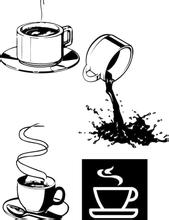The way of picking and handling Coffee introduction to the varieties of Coffee growing areas in picking season
The way of picking and handling Coffee introduction to the varieties of Coffee growing areas in picking season
In Yunnan, this process is mainly accomplished by natural fermentation. The term fermentation is not 100% accurate because there is no biochemical reaction inside the coffee beans. It is more appropriate to call this process the use of biochemical reaction or hydrolysis to remove mucus. This reaction is caused by natural enzymes in coffee berries.
The fermentation time varies from 6 hours to 72 hours, depending on the temperature, the amount of mucus and the concentration of digestive enzymes. Put the coffee in a fermentor until the mucus is completely decomposed and the beans can be washed.
The key to ensuring the quality of coffee is to stop fermentation at the right time, because excessive fermentation can lead to the emergence of so-called smelly coffee beans. If the fermentation is insufficient or too slow, butyric acid or propionic acid will be produced, both of which will adversely affect the quality of coffee.
There are two ways to prepare coffee beans for the baking process. The method chosen has a significant impact on the final value and quality of coffee. The cheapest method of processing is called "drying", which is used for lower-grade coffee beans, while higher-quality coffee beans are processed by "wet treatment". Drying is used for unwashed coffee beans. Wet treatment is used for thoroughly washed or semi-washed coffee beans. Except for the more common use of drying in Brazil and Ethiopia, most Arabica coffee beans are processed by wet treatment. Some robastian coffee beans are also processed by wet treatment.
Drying is also known as sun-drying or non-washing: the drying method is relatively simple. First of all, spread the freshly picked fruit on the exposure field for a week or two until the fruit crackles and dries naturally. After that, the dried pulp, endocarp and silver peel are removed by a sheller.
Advantages: the fruity aroma of coffee beans can be well preserved and the price is low.
Disadvantages: coffee beans may be contaminated with the fishy smell of the ground, and the quality of coffee beans is uneven.

Important Notice :
前街咖啡 FrontStreet Coffee has moved to new addredd:
FrontStreet Coffee Address: 315,Donghua East Road,GuangZhou
Tel:020 38364473
- Prev

Gouache proportion of coffee brewing reference-drip coffee pot gouache ratio
Gouache ratio of coffee brewing reference-dripping coffee pot gouache ratio many coffee lovers are at a loss when making one person's coffee, some people say that one more person will multiply by two, and some will use less than 2 grams of powder for each additional person, that is to say, if one person brews a cup of 180ml coffee with 14 grams of powder, once it is increased to two, just need
- Next

Which is better, the coffee hammer wood handle or the stainless steel handle?
Which is better, coffee powder hammer wood handle or stainless steel handle? in addition, there is another situation, which is more obvious when using two-cup bowls. Coffee production is relatively smooth, coffee flow is smooth, and is relatively fine flow down, the extraction of 30cc coffee amount of time is slightly longer (more than 30 seconds), then according to the above basically no problem. But if you take off the handle and observe it, you will find that on pressed powder
Related
- What brand of black coffee is the most authentic and delicious? what are the characteristics of the flavor of the authentic Rose Summer Black Coffee?
- Introduction to the principle and characteristics of the correct use of mocha pot A detailed course of mocha pot brewing coffee is described in five steps.
- Which is better, decaf or regular coffee? how is decaf made?
- How much is a bag of four cat coffee?
- How about four Cat Coffee or Nestle Coffee? why is it a cheap scam?
- Which is better, Yunnan four Cats Coffee or Nestle Coffee? How about cat coffee? is it a fake scam? why is it so cheap?
- How about Cat Coffee? what grade is a hoax? which instant coffee tastes better, four Cat Coffee, Nestle Coffee or G7 coffee?
- Process flow chart of coffee making-Starbucks coffee making process what coffee tastes good at Starbucks
- The top ten best coffee beans in the world Rose summer coffee or Tanzanian coffee tastes good
- Yunnan four cat coffee is good to drink?_four cat coffee is a big brand? four cat blue mountain coffee is fake?

